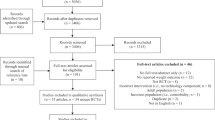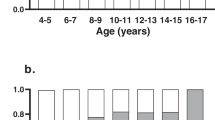Abstract
OBJECTIVE:
To use epidemiological data and a standardized economic model to compare projected costs for obesity prevention in late adolescence accrued using a cross-sectional weight classification for selecting adolescents at age 15 years compared with a longitudinal classification.
METHODS:
All children born in a Swedish county (population 440 000) in 1991 who participated in all regular measurements of height and weight at ages 5, 10 and 15 years (n=4312) were included in the study. The selection strategies were compared by calculating the projected financial load resulting from supply of obesity prevention services from providers at all levels in the health care system. The difference in marginal cost per 1000 children was used as the primary end point for the analyses.
RESULTS:
Using the cross-sectional selection strategy, 3.8% of adolescents at age 15 years were selected for evaluation by a pediatric specialist, and 96.2% were chosen for population-based interventions. In the trajectory-based strategy, 2.4% of the adolescents were selected for intensive pediatric care, 1.4% for individual clinical interventions in primary health care, 14.0% for individual primary obesity prevention using the Internet and 82.1% for population-based interventions. Costs for the cross-sectional selection strategy were projected to USD463 581 per 1000 adolescents and for the trajectory-based strategy were USD 302 016 per 1000 adolescents.
CONCLUSIONS:
Using projections from epidemiological data, we found that by basing the selection of adolescents for obesity prevention on weight trajectories, the load on highly specialized pediatric care can be reduced by one-third and total health service costs for obesity management among adolescents reduced by one-third. Before use in policies and prevention program planning, our findings warrant confirmation in prospective cost-benefit studies.
This is a preview of subscription content, access via your institution
Access options
Subscribe to this journal
Receive 12 print issues and online access
$259.00 per year
only $21.58 per issue
Buy this article
- Purchase on Springer Link
- Instant access to full article PDF
Prices may be subject to local taxes which are calculated during checkout

Similar content being viewed by others
References
Koeppen-Schomerus G, Wardle J, Plomin R . A genetic analysis of weight and overweight in 4-year-old twin pairs. Int J Obes Relat Metab Disord 2001; 25: 838–844.
Han JC, Lawlor DA, Kimm SY . Childhood obesity. Lancet 2010; 375: 1737–1748.
Oude Luttikhuis H, Baur L, Jansen H, Shrewsbury VA, O’Malley C, Stolk RP et al. Interventions for treating obesity in children. Cochrane Database Syst Rev 2009; (1): CD001872 (online).
Thompson D, Baranowski T, Cullen K, Watson K, Liu Y, Canada A et al. Food, fun, and fitness internet program for girls: pilot evaluation of an e-Health youth obesity prevention program examining predictors of obesity. Prev Med 2008; 47: 494–497.
Carter-Edwards L, Bastian LA, Schultz M, Amamoo MA, Ostbye T . An internet-based weight loss intervention initiated by a newspaper. Prev Chronic Dis 2009; 6: A101.
McConnon A, Kirk SF, Ransley JK . Process evaluation of an internet-based resource for weight control: use and views of an obese sample. J Nutr Educ Behav 2009; 41: 261–267.
Cole TJ, Bellizzi MC, Flegal KM, Dietz WH . Establishing a standard definition for child overweight and obesity worldwide: international survey. BMJ 2000; 320: 1240–1243.
Janssen I, Katzmarzyk PT, Srinivasan SR, Chen W, Malina RM, Bouchard C et al. Utility of childhood BMI in the prediction of adulthood disease: comparison of national and international references. Obes Res 2005; 13: 1106–1115.
De Souza CT, Araujo EP, Bordin S, Ashimine R, Zollner RL, Boschero AC et al. Consumption of a fat-rich diet activates a proinflammatory response and induces insulin resistance in the hypothalamus. Endocrinology 2005; 146: 4192–4199.
Munzberg H, Myers Jr MG . Molecular and anatomical determinants of central leptin resistance. Nat Neurosci 2005; 8: 566–570.
Morton GJ, Cummings DE, Baskin DG, Barsh GS, Schwartz MW . Central nervous system control of food intake and body weight. Nature 2006; 443: 289–295.
Berthoud HR . Mind versus metabolism in the control of food intake and energy balance. Physiol Behav 2004; 81: 781–793.
Carter R, Moodie M, Markwick A, Magnus A, Vos T, Swinburn B et al. Assessing cost-effectiveness in obesity (ACE-obesity): an overview of the ACE approach, economic methods and cost results. BMC Public Health 2009; 9: 419.
Reagan PB, Salsberry PJ . Pathways to adolescent overweight: body mass index and height percentile change in childhood. Int J Pediatr Obes 2010; 5: 80–87.
Huang R, de Klerk NH, Smith A, Kendall GE, Landau LI, Mori TA et al. Lifecourse childhood adiposity trajectories associated with adolescent insulin resistance. Diabetes Care 2011; 34: 1019–1025.
McCoy MR, Couch D, Duncan ND, Lynch GS . Evaluating an internet weight loss program for diabetes prevention. Health Promot Int 2005; 20: 221–228.
Goessens BM, Visseren FL, de Nooijer J, van den Borne HW, Algra A, Wierdsma J et al. A pilot-study to identify the feasibility of an Internet-based coaching programme for changing the vascular risk profile of high-risk patients. Patent Educ Couns 2008; 73: 67–72.
Lingfors H, Lindstrom K, Persson LG, Bengtsson C, Lissner L . Lifestyle changes after a health dialogue. Results from the Live for Life health promotion programme. Scand J Prim Health Care 2003; 21: 248–252.
Soderlund LL, Nordqvist C, Angbratt M, Nilsen P . Applying motivational interviewing to counselling overweight and obese children. Health Educ Res 2009; 24: 442–449.
Acknowledgements
Annual ALF financing (a special government subsidy) was obtained from Östergötland County Council, Sweden. The funding agency did not influence the research process in any aspect. We are grateful to all school health care nurses and physicians who made this study possible.
Author information
Authors and Affiliations
Corresponding author
Ethics declarations
Competing interests
The authors declare no conflict of interest.
Rights and permissions
About this article
Cite this article
Ekberg, J., Angbratt, M., Valter, L. et al. History matters: childhood weight trajectories as a basis for planning community-based obesity prevention to adolescents. Int J Obes 36, 524–528 (2012). https://doi.org/10.1038/ijo.2011.263
Received:
Revised:
Accepted:
Published:
Issue Date:
DOI: https://doi.org/10.1038/ijo.2011.263
Keywords
This article is cited by
-
Bayesian hierarchical piecewise regression models: a tool to detect trajectory divergence between groups in long-term observational studies
BMC Medical Research Methodology (2017)
-
Design of an online health-promoting community: negotiating user community needs with public health goals and service capabilities
BMC Health Services Research (2013)



